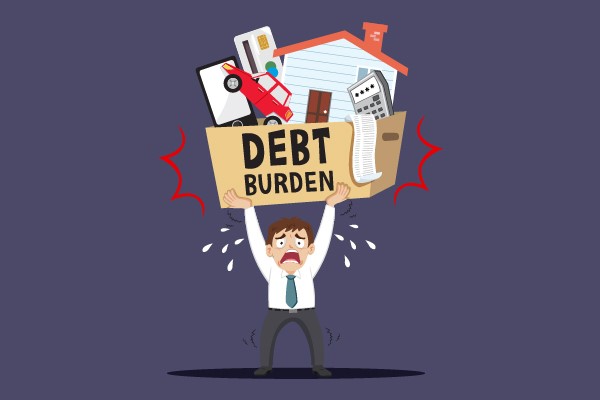Debt Trap – Meaning, Causes, Indicators and How to Avoid It?

What is a Debt Trap?
A debt trap means a trap that occurs when a borrower is compelled to take out more loans in order to pay off previous ones. In essence, a debt trap happens when financial responsibilities outweigh a person’s ability to repay loans.
Payday loans could be one debt trap example, Payday loans are short-term loans with high interest rates and fees. Borrowers who can’t repay on time may take out another loan, leading to a cycle of debt that’s hard to escape.
How Does a Debt Trap Work?
The main loan amount (the amount you borrow) and the interest rate are two factors that come into play whenever you take out a loan from a moneylender (the amount the lender charges on the principal loan amount). Once your principal starts to drop, can you start moving forward with loan repayment? But, every month that you pay back the loan, you contribute to both the principal and the interest. This is due to the amortizing structures of most loans. This means that each payment you make towards your loan applies to both the principal and the interest, and that your loan is intended to be repaid over the course of a certain number of fixed installments. And if you cannot make the payment, you are most likely to fall into debt traps.
As it becomes very impossible to pay off your loan because the principal doesn’t decrease and the interest keeps accruing.
Indicators of Debt Trap
1. EMI Salary Ratio
The EMI salary ratio is a financial metric that compares a person’s monthly loan repayment amount to their monthly income. This ratio helps determine if a person can afford to take on a new loan while managing their current expenses.
For Example : if your EMI is ₹5000 and your salary is ₹15,000 your EMI-salary ratio is 0.5. Professionals recommend that ratio should be below 0.3.
2. High Levels of Personal Debt
A high level of personal debt, especially unsecured debt like credit cards and personal loans, can suggest that individuals are living beyond their means and may be at risk of falling into a debt trap.
For example : if a person has multiple credit cards and personal loans with high balances and struggles to make minimum payments, it can result in a cycle of borrowing and high-interest payments.
3. Lack of Financial Education
A lack of financial education can make individuals more vulnerable to falling into a debt trap, as they may not have the necessary knowledge to manage their finances effectively.
For example : If a person borrows money without understanding the interest, time limit, it can lead to a debt trap.
Causes of Debt Trap
Let’s check out a few reasons that causes debt trap:
1. EMIs Exceed 50% of Your Income
Compulsive spending might strain your budget and end up creating a debt trap for you. If you become an impulsive buyer and fall prey to EMI schemes or discounts, you become more prone to falling into a debt trap. Therefore, you must be mindful of your finances before buying out of impulse.
2. Fixed Expenses are More than Your Income
Nowadays, product marketing is making people want things they do not actually require. Additionally, there are a huge number of financial companies ready to provide you loans with just the minimal documentation. This makes it easy for people to spend more than they earn.
If your fixed expenses are more than your income, this might be another reason behind a debt trap. Taking a number of loans at once might create such a situation.
3. Exhausting Credit Limit
Credit card debt is the easiest way to get into debt trap as most people get attracted by the exciting offers and get involved in never-ending credit card bills. On the other hand, credit card companies charge quite a lot of interest, which might range from 16 to 32% per annum.
4. Multiple Loans
If you are juggling multiple personal loans as well as credit card bills, you might be short on your living expenses. In such a situation, taking a single low-interest personal loan and consolidating all your loans under one umbrella might be a great plan. It will ensure timely repayment of your loan and peace of mind. However, taking successive loans to pay your debts might not be such a wise choice.
5. No Repayment Plan
Credit cards and loans might look tempting; however, before opting for them, you must come up with a repayment strategy. Using an EMI calculator for calculating your estimated EMI before applying for a loan might help you plan your repayment strategy better.
Borrowing might be easy but repaying it can get tough if you do not have a repayment plan.
How Does a Credit/Loan Push the Borrower Into a Debt Trap?
Applying for credit cards or loans in a high-risk position could lead to issues or put the borrower in a debt cycle.
For example, a chef takes a loan for raw materials for his restaurant, but due to low demand, the individual struggles to earn a profit, so he takes another loan to recover from the loss and repay the previous loan.
Unfortunately, the individual experiences the same problem twice and is unable to repay the debt. This is referred to as a debt trap: a circle of loans that the borrower finds challenging to escape.
Also Read
How to Avoid Falling Into a Debt Trap?
If you are already in a debt trap, coming out of it might seem impossible. However, it is not, and there are certain steps that you can take to come out of your debt before you get trapped completely.
Here are some ideas that can help you escape from an impending debt trap:
1. Check Your Priorities
Sometimes people tend to spend their money extravagantly without checking their expense heads and spending patterns. To avoid this, it is essential to create a priority list to segregate your needs. Categorize your needs into essential, semi-essential and non-essential. Try to focus only on the essential items.
By making a budget and tracking your monthly expenses, you can identify and prevent all wasteful expenses. This will help in minimizing your discretionary and unwanted spending and help to focus on the necessities. A disciplined approach will guide you to improve your spending habits and help in reducing the risk of falling into a debt trap. To avoid spending money recklessly, create a priority list to segregate your needs. You can also categorize your needs into essential, and semi-essential and focus more on the essential items. This will help you impro
2. Build an Emergency Fund
One of the best ways to avoid a debt trap is to have an emergency fund. An emergency fund consisting of your 6 months’ salary should be kept aside. With an emergency fund, you can sail across the stormy seas of financial uncertainties. It will help to run things smoothly momentarily and avoid a debt trap for a few months until the situation stabilizes.
3. Avoid Taking More Debts
You should not take any more debts to pay your previous ones. This is an important step towards avoiding a debt trap. If you keep taking loans to repay your previous loans, your monthly commitments will rise, which will only add to your mental and financial stress. This might be a bit hard to practice as avoiding borrowing means you might not be able to purchase certain things until you earn the money. However, you must stick to the rule of not going for impulsive purchases.
4. Get Rid of High-interest Loans First
Categorize your loan as short-term and long-term. Short-term debts might include personal loans and credit card loans, while long-term loans include home loans. After this, you can focus on getting rid of the more expensive loans that have higher interest rates.
5. Automate Your EMIs and Utilities Bills
You can authorize a bank or concerned organization to automate your EMI and utility bill payment. These bills are important and need to be paid on time without fail. A system automatically collecting payment for these bills might solve the problem.
6. Consider Debt Consolidation
Debt consolidation can simplify your debt trap, you can consolidate all your loans under a single loan. If you choose this option, you will not have to worry about repaying multiple loans with different interest rates and different due dates.
Opting for a new personal loan with a lower interest rate in comparison with your old debts will help in reducing EMI outflow.
7. Insurance Policy to Protect You
Get enough insurance to safeguard you and your family from unforeseeable situations. . If you have insurance, you can allocate all your savings to debt repayment without worrying about escalating medical costs.
Difference Between Good Debt and Bad Debt
| Good Debt | Bad Debt |
| Good debt is debt used to purchase an item that will create income for a long time. | Bad debt is a loan that cannot be repaid and must be written off, also buying an asset that doesn’t generate income can also be referred to as Bad Debt |
| Example: Home Loan, Student Loan, Business Loan, etc. | Example: Credit cards, personal loans, payday loans etc |
Final Word
Almost all of us had taken out loans when we needed money, but managing funds poorly could be disastrous, leading to a debt trap. Tracking your income and expenses to determine how your money is spent can help you avoid falling into a debt trap.
Want to take out loans but scared of the debt trap? Don’t worry, get a Navi cash loan with flexible EMIs.
FAQs
Staying in debt isn’t wrong. However, piling up debts without having a proper financial plan can be disastrous. So, close your credit card or existing loans early only if you feel that your existing debts are causing financial stress.
If you have various loans with varying tenures, you can talk to your bank about consolidating these loans into one and reorganising the interest and tenure in a manner that is appropriate for your new situation. If you carry out these steps, you can reduce the interest rate. You can also try to negotiate with the bank to lengthen the term of the loan to cut down on the amount of the EMI payments.
If you’re sure of your repayment capacity then there’s nothing to worry about piling debt. It always depends on how smartly you can manage your money, repayments, etc.
Debt-trap diplomacy is an international financial arrangement in which a creditor country or institution lends money to a borrowing country either partially or entirely in order to give the lender more political clout.
Personal Loan in Your City

Customer’s Feedback
No comments found.10 Best Bank for Savings Account in India [Highest Interest Rate 2023]
Savings account is a type of financial instrument offered by several banks. It lets you safely depo... Read More »What is Issuer Identification Number (IIN)- Working and Importance
What is an Issuer Identification Number (IIN)? Banks and financial institutions assign a distinc... Read More »What is a Vostro Account – Meaning, Working and Difference
What is a Vostro Account? A Vostro account is a bank account held by a domestic bank on behalf o... Read More »What is a Solvency Certificate? – Format, Documents Required & How to Apply Online?
What is a Solvency Certificate? A solvency certificate is a legal document furnishing the detail... Read More »What is Merchant Banking – Services, Features, Functions and Example
What is Merchant Banking? Merchant banking is a set of select banking and financial services off... Read More »Automated Clearing House: Objectives, Types and Process
Automated Clearing House is an electronic fund transfer network that manages automatic and direct... Read More »How to Redeem Credit Card Reward Points ?
Credit Card Reward points are types of incentives that customers receive when they use a credit car... Read More »What is Electronic Clearing Service (ECS) in Banking and How does it Work?
What is Electronic Clearing Service (ECS)? Electronic Clearing Service (ECS) is a method of elec... Read More »What are Credit Card Validators and How to Use them?
What is a Credit Card Validator? A credit card validator is a tool that checks the validity of a... Read More »What is Cash Management and How Does it Work?
Managing available capital can make sure that a small business stays afloat. Cash management is an ... Read More »What are Prepaid Expenses? – Definition, Examples, and Journal Entry
Prepaid expenses represent payments made in advance for products or services expected to be incurre... Read More »Increase Credit Card Limit – Important Tips and How to Do It?
The credit card limit is the maximum amount of money you can spend using your credit card. Your cre... Read More »Top 10 Chit Fund Schemes in India in 2023
Chit funds are one of the most popular return-generating saving schemes in India. It is a financial... Read More »10 Best Gold ETFs in India to Invest in April 2023
Gold ETFs or Gold Exchange Traded Funds are passively managed funds that track the price of physica... Read More »10 Best Demat Accounts in India for Beginners in 2023
Creation of Demat accounts revolutionised the way trades were conducted at the stock exchanges. It... Read More »20 Best Index Funds to Invest in India in April 2023
What is an Index Fund? An index fund is a type of mutual fund or exchange-traded fund (ETF) that... Read More »Best Arbitrage Mutual Funds to Invest in India in April 2023
Arbitrage funds are hybrid mutual fund schemes that aim to make low-risk profits by buying and sell... Read More »10 Best SIP Plans in India to Invest in April 2023
What is SIP? SIP or Systematic Investment Plan is a method of investing a fixed amount in ... Read More »10 Best Corporate Bond Funds in India to Invest in April 2023
Corporate bond funds are debt funds that invest at least 80% of the investment corpus in companies ... Read More »10 Best Bank for Savings Account in India [Highest Interest Rate 2023]
Savings account is a type of financial instrument offered by several banks. It lets you safely depo... Read More »





















